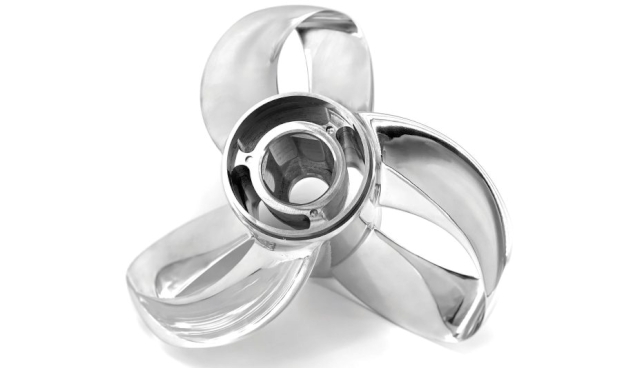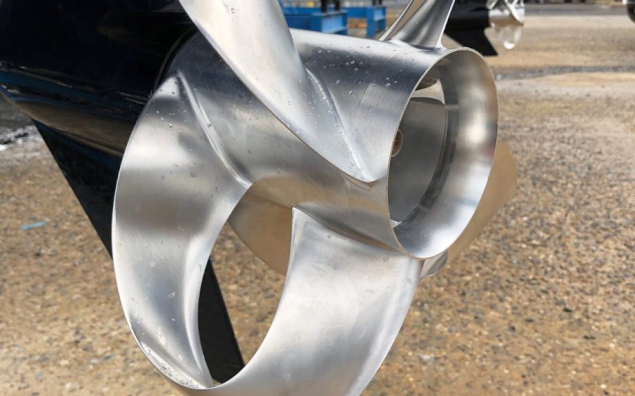Hugo Andreae takes a look at a revolutionary new propeller said to be faster and more efficient than rivals
A radical new tipless propeller is being touted as the single biggest advance in propeller design since the 1930s. Claimed to deliver significant fuel savings across all different types and sizes of craft as well as faster planing, higher top speeds, superior handling and reduced vibration, it sounds almost too good to be true.
However, extensive sea trials carried out by US website boattest.com on the new Sharrow Propeller MX-1 seem to confirm all of the above and show efficiency gains of between 9-15% over comparable 3-blade propeller designs.
The tests were carried out on a 20ft Bayliner VR5 sportsboat fitted with a standard Mercury 150hp outboard engine, comparing Sharrow’s new tipless MX-1 against two market leading-competitors. Not only was it the fastest of the three (41.7 knots vs 40.8 knots and 39.0 knots) and the most efficient (4.6mpg @ 32 knots vs 4.2mpg and 4.1mph), it also planed earlier and outperformed them both at every 500rpm increment from idle speed to wide open throttle.
This is crucial, as propellers that are designed to give the highest possible top speed often struggle at low to medium revs, and vice versa. So how is Sharrow Engineering claiming to have cracked the conundrum that has stymied so many others?
Tip troubles
As ever it seems to be a combination of inspiration and perspiration. The inspiration came from its inventor and CEO of Sharrow Engineering, Greg Sharrow, a music graduate, who originally set out to solve a very different problem.
He wanted to use camera drones to film performers in action but soon found that their microphones would pick up the noise of the drones. He realised that most of this noise was not being created by the drone’s tiny electric motors but by the propeller tip vortices.
These swirling pockets of turbulence are caused by high-pressure air on one side of the blade rushing round to meet the low pressure air on the other, creating induced drag, noise and vibration. The same principle applies to boat propellers, where the tip vortices are even more pronounced and can lead to cavitation, when water is momentarily vapourised by the sudden change in pressure creating bubbles.
Greg reasoned that if he could reduce or even eliminate these tip vortices, it should lead to a quieter, more efficient drone. His light bulb moment came on a dog walk when the idea of a tipless blade, that loops round to rejoin the propeller hub like a strip of twisted ribbon, first popped into his head.
It took a further seven years of intensive research and development, substantial investment, 23 worldwide patents and a switch in focus from drones to boats before Sharrow Engineering unveiled its first production propeller at the Miami Boat Show in February. Since then it has already won an award for innovation and the company says it is now in discussion with a number of major propeller and engine manufacturers.
Crucially, although its first offering, the MX-1, is a 15in diameter propeller with pitches from 15in to 21in designed for planing craft powered by outboard or sterndrive engines of 100-450hp, it can and already has supplied custom made propellers for much larger craft, including one for a 65ft planing motoryacht.
It has also modelled and simulated tests on propellers up to 9.87m in diameter for displacement trawler yachts, container ships and even super tankers, all of which have shown similar theoretical efficiency gains. Much of this modelling and prototype work was carried out by the University of Michigan’s Marine Hydrodynamics Laboratory and involved scale tank testing to prove its findings.
Furthermore, speaking to MBY, Boattest.com’s founder and president Jeff Hammond, confirmed it wasn’t just the performance data that astounded his two test captains but the transformation in the boat’s cruising refinement and handling. Both captains reported less vibration, quieter running and exceptional grip in turns.
This appears to be due to a number of different dynamic advantages, including the Sharrow propeller’s ability to draw in more water from the side, the extra traction of what amounts to a six-bladed design and the exacerbated effect of the reduction in induced drag during turns.
Price point
The only obvious drawback is price. Currently, every MX-1 propeller has to be milled from a solid billet of metal, which helps explain the price of $4,500 for an aluminium MX-1 or $9,000 for a stainless steel one.
However, as Greg Sharrow pointed out in an interview with MBY: “The first Dyson vacuum cleaner cost $10,000, now you can buy one for a couple of hundred.” He also confirmed that in the longer term a move to series-production casting could reduce the price of the MX-1 significantly.
Until we can sea trial one of these new Sharrow Propellers for ourselves we won’t know for sure whether the claims being made for it are as game changing as they seem. Although we have every confidence in boattest.com’s findings, they were only performed on one boat, and unlike Motor Boat & Yachting’s sea trials, its tests are paid for by the manufacturer.
However, the science and the data do point to a significant breakthrough. We look forward to verifying it in the future with our own sea trials.
First published in the June 2020 edition of Motor Boat & Yachting.





